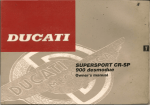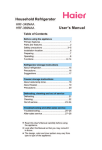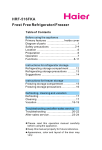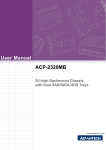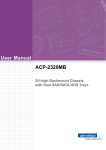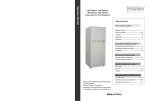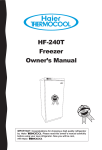Download Haier HRF-288K User's Manual
Transcript
Operation Manual HRF-288K/318K/348K Household Refrigerator Table of Contents Before using the appliance Primary features----------------- Inside front cover Diagram of parts -------------------------------------1 Safety precautions--------------------------------2~4 Location-------------------------------------------------5 Preparation---------------------------------------------6 Operation------------------------------------------------7 Functions-------------------------------------------8~12 Instructions for refrigerating storage Refrigerating storage compartment--------------13 Refrigerating storage precautions----------------14 Suggestions-------------------------------------------15 Instructions for freezer zone 1 Freezor zone 1 compartment---------------------16 Instructions for freezer zone 2 Freezing storage compartment-------------------17 Freezing storage precautions---------------------18 Defrosting, cleaning and vacation Defrosting---------------------------------------------19 Cleaning------------------------------------------------20 Vacation-------------------------------------------21~22 Question answering and Troubleshooting Serial Number:0060506138 ·Please read this operation manual carefully before using the appliance. ·Keep this manual in a safe place. ·Appearance, color and layout of the door according to the prodct. Question answering---------------------------23~24 Troubleshooting------------------------------25~26 Primary features ①Four temperature zones Four temperature zones for satisfaction of varied storage needs. ②Chiller zone Unique refrigeration technology for -2oC~+3oC storage condition suitable to preserve fresh food nutrition. ③Freezer zone 1 Defrosting is not required before service for the food stored in the -7oC freezer zone. ④Fuzzy operation mode If this mode is set, the appliance will adjust inside temperature automatically according to ambient temperature to optimize the storage condition. ⑤Over-temp alarm Enabling the user to identify abnormal performance of the appliance. Diagram of parts ⑧ ⑨ ① 10 ② 11 ③ ④ 12 ⑤ ⑥ ⑦ ① Light ② Shelves ⑤Freezer zone 1 (-7oC) ⑧Low bottle holder cover 10Small bottle holder cover ③ Crisper ④ Chiller zone (-2oC~+3oC zone) ⑥ Freezer zone 2 (-16oC~-26oC) ⑦ Plug ⑨ Low bottle holder 11 Small bottle holder 12High bottle holder Dear customer: Thank you for your purchasing Haier product. Please read this manual carefully before using the electrical appliance that you have just purchased. Due to product moditication, your purchased Haier refrigerator may have some difference with which shown in the manual. We apologize here. 1 Safety precautions This refrigerator requires a 220V/50Hz power supply. It is required to use seporate dedicated outlet with securely grounding. 220V〜 50Hz Care for external cable ● Hold the plug, not the electric cable, when unplugging the refrigerator. ● Ensure that the electric cable is not trapped by the refrigerator. Do not step on the cable. ● Avoid damage to the electric cable when moving the refrigerator. Damaged electric cable When the electrical cable is damaged or worn, turn off the refrigerator and consult to an authorized service agent for replacement. Inflammable gas leakage in the vicinity of the refrigerator Unplug the refrigerator for the following: ● Cleaning or maintenance. ● Replacement of lamp. ●Turn off any leaking valve. ●Open the doors and windows. ●Do not, under any circumstances, unplug electrical appliances in the vicinity of the leak. 2 Safety precautions Bacterin Alk ali A ci d Gas Spray Mousse in the refrigerator. This refrigerator should be used for food storage. It is not recommended to place microbiological or chemical materials, which have special requirement in temperature setting. Vaccine Never store inflammable, explosive or corrosive materials Chemical Agent Do not install the refrigerator near gasoline or other inflammable articles.. Don't place electrical plugs, regulators or microwaves on top of the refrigerator. Don't use electric appliances inside the refrigerator. Do not swing on or apply excessive pressure to the refrigerator door. Don't place heavy or unstable articles or water containers on top of the refrigerator. 3 Safety precautions 4 Avoid prolonged contact with the surface in the freezer compartment when the refrigerator is operational, especially with wet hands. Hands may freeze onto the surface of the frozen parts. Do not spray or splash the refrigerator when cleaning the Disassembly, renovation or cooling system maintenance of refrigerator must be authorized. Never store bottled beer or beverages in the freezer compartment. Unplug the refrigerator in the event of a power interruption or during cleaning. Allow at least 5 minutes lapse before restarting the refrigerator. Remove the refrigerator door and door gasket if the refrigerator is discarded to prevent accidental entering a child in the refrigerator. refrigerator, nor place the refrigerator in a damp area. Location The refrigerator should be placed on a flat and solid surface. If the refrigerator is to be leveled, a flat, strong and fireresistant material must be used. The front foot of the refrigerator can be adjusted clockwise or anti-clockwise to lift or lower the refrigerator if it is placed on an uneven surface. Adjustable Foot Clockwise Anti-clockwise The refrigerator shall be placed away from heat sources The refrigerator should be placed in a well-ventilated or direct sunlight. area, and a space of 10cm or more should be allowed around the refrigerator. Min. 10cm Space Min. 10cm Min. 10cm Never place the refrigerator near to a water source. Never place the refrigerator in an area with an ambient Clean and dry any water splashes and stains with soft temperature below 5°C. Never operate the refrigerator cloth. outdoors or in rain. 5 Preparation ① ② Unpacking Remove all packing materials. Check attached accessories and materials. Check if all accessories specified in the Packing List are available. Contact the local distributor if shortage is found. ③ Ensure that the refrigerator is properly located. (See section "Location") ④ Clean the refrigerator before using. (See section "Cleaning") ⑤ Time lapse before power supply Connect the refrigerator to power source at least 30 minutes after the refrigerator is sited and cleaned. 6 Operation ① Connection to power supply ② Setting of operation mode When the appliance is first connected to power supply, the fuzzy operation mode is set automatically, the super freezing icon is not displayed, super freezing mode cannot be set, the lock-on icon is not displayed and the lock-on mode is not activated. However the over-temp alarm icon is displayed. Suggestion ! Regardless of irrespective fluctuations in ambient temperature, selection of the Fuzzy Operation Mode will guarantee the most efficient and energy-saving operation of the refrigerator. Either of the following operation modes can be selected. (1) Fuzzy operation mode: If there is no requirement for a specific operation setting, the fuzzy operation mode is recommended. Hold the Fuzzy Operation Mode button pressed for 3 seconds after the lock-off mode is set, the mode will be activated with the icon displayed. (See section "Functions") (2) Manual adjustment mode: Press the temperature setting button to set the temperature when the lock-off mode is set. (See section "Functions") ③ Loading the refrigerator with food Load the refrigerator with food when the set temperature of the refrigerator compartments is reached and the over-temp alarm icon extinguishes.. Some time will be required for the refrigerator to reach the set point when the Caution temperature is adjusted. The length of this period is determined by difference in the existing and set temperatures, the ambient temperature, the frequency with which the door is opened and closed and the amount of food in storage. 7 Functions ⑴ Control panel A------Refrigerating temperature setting / (Pressed for 3 seconds under lock-on mode) Refrigerator compartment on/off ℃ ℃ ℃ H K E F G I J L A B C FUZZY D B------Freezer zone 1 temperature setting / (Pressed for 3 seconds under lock-on mode) Freezer zone 1 compartment on/off C------Freezer zone 2 temperature setting / (Pressed for 3 seconds under lock-on mode) Super freezing setting D------Fuzzy operation setting / (Pressed for 3 seconds under lock-on mode) display screen off C+D------Lock-on/Lock-off E------Refrigerator average temperature display F------Freezer zone 1 average temperature display G------Freezer zone 2 average temperature display H------Fuzzy operation mode icon I------Super freezing mode icon J------Lock-on icon K------Over-temp and error alarm icon L------ Operation icon Note: These block English letters in front of the phrases above listed will be used hereinafter to represent the phrases thereof. ⑵ ℃ Lock-on and Lock-off modes ℃ ℃ J If button C and D are pressed under the lock-off mode, icon J will be displayed and lock-on mode is set. If button C and D are pressed again under the lock-on mode, icon J will be disappear and lock-off mode is set. C FUZZY D 8 Functions Caution! The following functions 3, 4, 5 and 6 can be operated under the lock-off mode. (Icon J disappears) ⑶ Fuzzy operation mode(This section can be skipped if Manual Setting Mode is set.) ●This mode is designed to ensure normal operation of the refrigerator under variable ambient temperature. ●Temperature in refrigerator compartments is automatically adjusted according to variations of ambient temperature. ℃ ℃ ℃ H Hold button D pressed for 3 seconds then icon H will be displayed and the fuzzy operation mode is set. Pressing button D again for 3 seconds until icon H disappears can inactivate the fuzzy operation mode. If the fuzzy operation mode is set, the refrigerating and freezing FUZZY temperature and super freezing mode cannot be reset, but D Caution the temperature of freezer/zone is adjustable. ⑷ Refrigerating temperature setting (This section can be skipped if Manual Setting Mode is set.) E ℃ If button A is pressed, the refrigerating temperature can be reset and icon E of originally set refrigerator value blinks. Every press of button A will result in an increase of the refrigerating temperature by 1°C between 2°C and 10°C. 5 seconds later after the latest press, the icon of set temperature value will cease blinking and icon E will display average temperature in the refrigeration compartment. ℃ ℃ A 9 Functions ⑸ Freezer zone/temperature setting The temperature in the freezer zone 1 can be adjusted between -3°C and -18°C. If button B is pressed, icon F for the originally set temperature of freezer zone 1 will blink, then every press of button B will result in an increase of the temperature from -3°C to -18°C. Blinking of temperature value icon will cease and icon F of the freezer zone 1 average temperature will be displayed. ⑹ ℃ Freezer zone 2 temperature setting (This section can be skipped if Fuzzy Operation Mode is set.) After pressing button C, freezing temperature can be reset and icon G of originally set refrigerator value blinks. Every press of button C will result in a decrease of the freezing temperature by 1 °C between -16°C and -26°C. 5 seconds later after the latest press, the icon of set temperature value will cease blinking and icon G will display average temperature in the freezer zone 3. ⑺ ℃ ℃ G C Super freezing setting(Under the condition of Fuzzy off) ℃ ●Super freeze function is designed to preserve the nutritional value of food, as the food will freeze completely in the shortest period possible. When lock-on mode is set (icon J appears): Hold button C pressed for 3 seconds, icon I will be displayed and the super freezing operation setting mode is set. This mode can also be manually inactivated by holding button C pressed for 3 seconds again and the super-freezing mode can will automatically cease after the compressor has run some time. ℃ ℃ I J C If the super-freezing mode is set, the temperature of freezer zone 2 cannot be Caution 10 adjusted while the temperature in the refrigerator and freezer zone 1 can be reset. Functions ⑻ Control display more than 3 seconds! The background light of the display screen extinguishes automatically 1 hour after the latest press of any button. ⑼ Refrigeration On/Off When lock-on mode is set (icon J appears): Hold button A for 3 seconds, icon E will disappear and cooling system of the refrigeration compartment ceases. If button A is pressed again for 3 seconds under the lock-on mode, icon E will appear and refrigerating mode will be activated. FUZZY D ℃ E ℃ ℃ J A ⑽ Freezer zone 1 On/Off ℃ ℃ When lock-on mode is set (icon J appears): Hold button B for 3 seconds, icon F will disappear and cooling system of freezer zone 1 ceases. If button B is pressed again for 3 seconds under the lock-on mode, icon F will appear and operation of freezer zone 1 will be activated. F ℃ J B 11 Functions ⑾ Over-temp warning If temperature in the refrigerator is above set value, icon K will be displayed. Check to see if the refrigerator door is tightly closed, or excessive hot food is loaded. Icon K will disappear automatically when the temperature inside the refrigerator cools down. If icon K remains display for an extended period, technical assistance should be required from the authorized agent. ⑿ ⒀ ℃ ℃ ℃ K Power interruption memory Operating status of the refrigerator can be remembered if power supply is interrupted. When power supply is regained, current operating status will be resumed. Error display E When problem occurs with any of the sensors, icon E or F will display F1, F2, F3, F4, F5 or F6 whichever is defective although the operation of this appliance will continue, Contact authorized service agent for technical assistance. 12 ℃ ℃ F G ℃ Refrigerating storage compartment The refrigerator is for short-term food storage or for daily consumption: Although the temperature in most areas in the refrigeration compartment can be regulated between 2oC and 10oC, extended periods of food storage is not recommended. Refrigerator should only be used for short-term storage. Storage areas As cold air circulates inside the refrigerator, temperature differences exist inside the storage compartments. Area 6 is the coldest. Different foods should be placed in different areas according to their properties. ① Eggs and butter ② Canned food and seasoning ③ Beverages and bottled food ④ Pickled and canned food ⑤Wheaten food, canned food, milk and bean curd ⑥ Cooked meat and sausages ⑦ Fruit, vegetables and salad ① ④ ⑤ ⑥ ② ⑦ ⑧ ③ ⑧Sliced raw fish, beef or mutton (for less than 3 days) ② Lamp and replacement Lamp: 220~240V~, 15W Lamp holder: E14 (lamps exceeding 15W must not be used) When replacing the lamp ●Unplug the appliance. ●①To release the lampshade, depress the clip at the back along the arrow;② Hold both sides of the lampshade and push ensuring that the lugs are freed from the square slots of the lamp holder. ●Rotate the lamp anticlockwise for removing and clockwise for installing. ●When replacing the lampshade, ensure that all the lugs of the lampshade are settled into the slots of the lamp holder. Lampshade Lamp ① Lamp holder Square Lug slots Square slots Clip 13 Refrigerating storage precautions Hot food must be cooled to room temperature before storing in the refrigerator. Dry any water droplets on the food before placing it in Food to be stored should be properly sealed. This will prevent moisture in the food from evaporating and prevent vegetables and fruit from tainting in flavor. Storage of sorted food Food to be stored should be sorted according to consumer requirements. Food consumed daily should be placed in the most convenient area, this will minimize the refrigerator. opening periods for the door. Do not store excess quantities or weights of food. Food should be stored with spaces in between for better storage results. Never overload shelves, as they may collapse under excessive loads. 14 Do not place food too close to the internal walls. Food with high moisture content should not be placed close to the walls of the inner liner. Maintain a space to prevent food from freezing to the walls. Suggestions Storage period will be extended if vegetables are placed with their roots towards the cold source. Leaves of carrots or turnips should be removed before Eggs should be stored vertically in the egg holder. Frozen food can be placed in the cold compartment before serving, as this will conserve energy. Onions, garlic, ginger, water chestnuts and other root vegetables should not be stored in the refrigerator, as these foods are suitable for long-term storage at normal temperatures. Ripe squash, melon, pawpaw, bananas and pineapples should not be stored in the refrigerator. Freezing will accelerate the ripening process. storage. Vegetables and fruits should be stored on the upper areas in the refrigerator o when ambient temperature is 0-10 C and the temperature in the lower area of Caution o the refrigerator compartment will be around 0 C. 15 Freezer zone 1 temperature compartment Temperature of the freezer zone 1 (See the label shown below) ranges between -3oC and 18oC. Advantages listed below can be achieved when the temperature of the zone is set between -3oC and -7oC. ●Defrosting free: Food in storage in this compartment can be prepared for cooking without manual or microwave defrosting ● Nutritional value preservation: Nutritional values of food in storage in the chiller compartment can be better preserved. ● Easy processing: Meat in here can be easily cut; Minced meat in chiller storage can serve directly. ● Stored overlapped food in here can be easily separated before serve. ● Extended storage period as follows: 14 days for meat and 7 days for fish on -7oC; 10 days for meat and 5 days for fish on -5oC; 7 days for meat and 3 days for fish and shrimps on -3oC. Proposed food for storage Fresh fish and meat, food with curry coating, minced meat, fresh fruit juice. Following food are not recommended to be stored: Ice cream and frozen food, which should be stored in the freezing compartment. Advantages of freezer zone 1 storage ●Fried food will be tested well if stored in here in advance. ●Cold dishes will become more delicious if stored here before serving ●Roasted sashimi and cuttlefish will be more delicious after stored in here. ●Salad will be more delicious after stored in here. ●Vegetables such as spinach stored in the compartment can be served after slightly steeped in hot water. ●Natural flavor of fresh fruits will be recovered after stored in here for a short time before consumed. ●Efficient cooling function for food can be achieved. Cutting may vary for the meat or fish with different moisture contents with differently sharpened kitchen knives. Adjust the temperature of the zone if necessary. Caution 16 Freezer zone 2 storage Long-term storage of food As the freezer storage temperature is very low, fresh food can be stored in the freezer compartment for a long time. Food requiring long-term storage can be stored in the frozen food compartment. Attention should be paid to the storage information printed on the food packing. Suggested storage period is as follows: Food Edibility (Month) Maximum (Month) Chicken, beef, mutton and shrimps 4 9 Dumplings, ribs 4 6 Cakes, breads, sliced meat and cheese 2 6 Seafood, sausages and ice-creams 1 3 Storage period is subject to the detailed information on the food packing, property of the food for storage and special requirements. Super freezing Select the quick freezing function before loading fresh food in the freezer compartment (see section concerned). The super freezing function is not required for food packages of less than 1kg or pre-frozen food. Making ice cubes ●Pour water into the ice cube tray up to threequarters of the mould volume, and then place the tray in the freezer compartment. ●Tilt a bit the front side of ice cube tray and never use a knife or metal tool when removing it from the refrigerator. ●Ice cubes can be easily removed after the tray has been placed in warm water for a short time. 17 Freezing storage precautions Hot food should not be stored in the refrigerator until Food cut into small portions will freeze faster and it has cooled down to room temperature. be easier to defrost and cook. The recommended weight for each portion is less than 2.5kg. The outside of any food packing should be dried before storage in the freezer, and any packing Food should be stored in accordance with any information printed on the packing. materials should be odor-free, airtight, nonpoisonous and nontoxic. 18 Only remove the required amount of food from the Do not load excessive quantity of food. Quantity of refrigerator. Defrosted food cannot be re-stored in the freezer unless it has been cooked. the food in storage shall comply with the cooling capacity of the refrigerator . Defrosting Defrosting the refrigerator The refrigerator is designed for automatic defrosting. Frost formed on the back wall will melt and flow via the drainpipe to the evaporating recipient over the compressor on the back of the refrigerator, where the heat generated by the compressor will evaporate the water. It is normal for frost and water droplets to form on the back wall of the refrigerator. Water outlet Cleaning Pin Always keep the drain over the fresh food container clear to ensure the normal Caution flow of defrosted water. Use the pin provided to clear any blockage. Defrosting freezer zone 1 and freezer zone 2 ●Manual defrosting is required for the freezer zone 1 and 2. After a period of operation, a layer of frost will form on the evaporator in the freezer compartments. Additional electricity will be consumed if this layer becomes too thick. ● The defrosting process must be carried out when a thick layer of frost has been formed on the evaporator. ● To defrost the compartment, first disconnect the power by unplugging the refrigerator, and then remove any food from the refrigerator and place it in a cool place. Remove and replace the drawers. A bowl of hot water can be placed on the evaporator to accelerate the defrosting process. Only the tools provided by the manufacturer can be used for defrosting. Caution 19 Cleaning The refrigerator should be cleaned regularly to prevent the formation of bad odors. ●Disconnect the power before cleaning the refrigerator. ●Clean the refrigerator with a soft cloth or sponge with mild detergent. Do not use a hard brush, steel brush, detergent, gasoline or other solvents, hot water, acid or alkali for cleaning. Caution ●Dry water droplets on surfaces of the refrigerator with a piece of cloth. Do not use excessive amounts of water for cleaning the refrigerator. Use a dry cloth to clean the switch and the lamp. Caution ● Regularly clean the surfaces of the external shell to improve the heat elimination efficiency. 20 ●Always keep the door gasket clean. Vacation Power interruption Even in summer, food can be stored in the refrigerator for a few hours after a power interruption. ●Don't load food into the refrigerator during a power interruption and try to open the door as less frequently as possible. ●If prior notice of a power interruption is given, make some ice and put it in a container in the top of the refrigeration compartment. Temperature in the refrigerator will rise because of power interruption or technical problems, then the food storage period will be reduced and quality Caution degraded. Ceased operation If the refrigerator is to be ceased for an extended period, unplug the refrigerator and clean the refrigerator as previously described. Keep the door of refrigerator open when the power is turned off to prevent any food remaining in the compartment from producing bad odors. Caution Caution It is recommended that the refrigerator be not turned off unless it is necessary. Do not restart the refrigerator until a period of at least five minutes has elapsed. 21 Vacation Before leaving for vacation ●Remove the food from refrigerator if the vacation is short. Turn the temperature selection knob to the proper position, and make sure that the door of the refrigerator is properly closed. ●If the vacation is long, take out the food from the refrigerator and disconnect the power. Wait until the frost inside melts, clean and dry the compartment. Leave the door open to prevent formation of bad odor. Moving the refrigerator ●Unplug the refrigerator. ●Remove all the food. ●Secure the shelves in the cold storage compartment, vegetable and fruit tray and drawers in the freezer with tape. ● Tightly close and tape the door of the refrigerator ● Do not tilt the refrigerator more than 45 degrees Never place the refrigerator horizontally. Caution 22 Question answering A slight sound may be heard when the appliance is first started due to the operation of the compressor and motor. The sound will be lower and lower gradually a short period later. Temperature of the refrigerator and the compressor will rise and the compressor will run for comparatively longer periods when the refrigerator is first started. Flowing refrigerant and compressor may produce a slight sound when the compressor starts or ceases operation. The two sides, the middle connection and rear panel of the refrigerator will be warm due to heat radiation of the appliance. Clatter Clatter 23 Question answering Energy efficiency specified in the technical parameters is measured under the following conditions: ambient temperature 25˚C, refrigerator compartment temperature 5˚C, freezer compartment temperature -18˚C and 24h continuous operation with doors closed. Actual power consumption may exceed this value if more food in storage, ambient temperature higher and the door more frequently opened. The evaporator and piping system of the refrigerator may produce a slight sound when the freezer operates and generates heat. Operation period of the compressor will be prolonged in summers as a result of higher ambient temperature. Poop Poop Water droplets may occur on outer surfaces and middle connection of the refrigerator due to heavy moisture in room air. Wipe clean with soft cloth. The thermostat, starting capacitor and heat protector may produce a slight sound when the refrigerator starts or stops. Clatter Clatter 24 Troubleshooting In the event that the refrigerator does not work properly, please check out and solve problems according to the following methods. If problems persist, contact the authorized service agent. Information of model, accessory list and serial number of the refrigerator is required. Please determine the cause of the problem before making any repair. The refrigerator does not operate. Checking if the power supply (plug, socket or fuse). Voltage is low Lamp does not illuminate. The bulb is bad Power supply is not connected Set temperature is not reached. Door is not properly closed, or the door is opened for long period Refrigerator is in direct sunlight, or close to a heat source; The area is poorly ventilated, or two sides of the refrigerator are covered by excess dusts. Strange odor Loud noise ●Failure to seal food properly ●Rotting food inside refrigerator ●Failure of regular cleaning of the refrigerator The appliance contacts a foreign article. The appliance is placed on an uneven surface. 25 Troubleshooting Before calling for repair, make sure the following items: Button inactive Automatic alteration on control panel ●Disconnection of power supply ●Wrong button is pressed. (see the section "Functions") ●Temperature display: disconnection of power supply or low voltage ●Fuzzy Operation mode: normal status Water spillage in refrigerator compartment Water drain is blocked. Clear the path with the cleaning pin. (See section "Defrosting") Cleaning pin Thick frost on the back of refrigerator ●Temperature is not properly set. See section "Operation" ●Door is not tightly closed. ●Door is frequently opened. ●Hot weather. ●Heavy moisture 26 Prolonged operation period of the compressor ●Initial operation. ●Large quantity of food loaded. ●Hot weather. ●Door not properly closed. ●Improper setting of temperature (see the section "Operation")





























